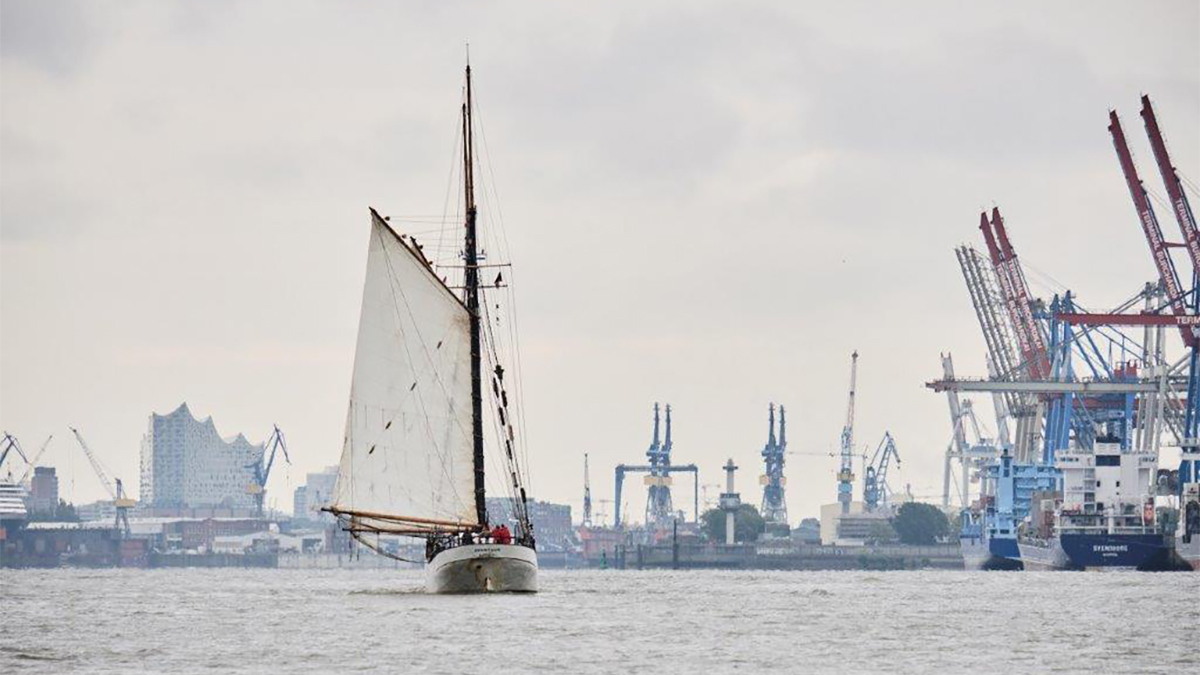Written by Christiaan De Beukelaer, Article No. 65 [UNCTAD Transport and Trade Facilitation Newsletter N°88 - Fourth Quarter 2020]

In the early morning of Thursday the 23rd of July 2020, I sailed into Hamburg aboard the Avontuur, a two-masted schooner built in 1920. After a trip across the Atlantic and back, we arrived in Germany with 65 tonnes of coffee, cacao, rum, and gin. It took the sailing vessel and its fifteen-strong crew, of which I was one, six months to complete the trans-Atlantic roundtrip via the Canaries, the Caribbean, Mexico, and the Azores. Throughout that time, we relied almost entirely on wind propulsion to carry these goods across the ocean.
A week after Avontuur completed the journey, on the 29th of July 2020, the International Maritime Organization released its 4th Study on the Reduction of Greenhouse Gas (GHG) from ships. This much-anticipated report looks at how GHG emissions from international shipping are likely to evolve across “a range of plausible long-term economic and energy scenarios.” It expects, crucially, that GHG emissions (expressed in CO2 equivalent) in 2050 will be 90-130% of what they were in 2008. This projection means that the shipping industry is likely to fall well short of meeting the IMO’s 2018 GHG emissions target, which aims to reduce total emissions by 50% relative to 2008 levels.
The question is: Will sailing vessels like the Avontuur help the shipping industry meet its climate goals? The short answer is: No.
Wind-propelled cargo vessels are currently operating on such a small scale that the emissions they might save are negligible. If the shipping industry as a whole is to make up the difference between its projected emissions (90-130% of 2008 levels) and its target (50% of 2008 levels) by 2050, it will need far more than a handful of small sailing cargo ships to accomplish this.
But does that mean the work of the “sail cargo movement” is futile? I think not.
Sailing vessels like the Avontuur may not have the capacity to decarbonise a significant share of the shipping industry. They do have something else: A clear mission to rethink both the way we ship things and how much we consume.
The Prevailing Winds of Sail Cargo
Some may dismiss the revival of cargo transport under sail as romantically appealing but ultimately unrealistic. And to some extent they are right: Sailing vessels cannot meet current transport demand in terms of speed or capacity. But their aim is not to meet this demand, for sail cargo initiatives argue that excessive consumption and travel is part of the problem.
Timbercoast, the German shipping company that has used the Avontuur to ship cargo since 2015, has done this as part of its “mission zero”, a mission to eliminate pollution caused by shipping cargo that consists of five steps:
- Raise Awareness about the environmental destruction caused by the shipping industry
- Model a clean shipping future with our Avontuur
- Sell premium Avontuur products to support the ongoing operation of the project
- Establish a demand for products shipped by sail
- Build a modern sail cargo fleet
In other words, Timbercoast is a commercial company that engages in direct climate action by trading goods under sail, while aiming to scale its business in order to gain a greater share of the shipping market.
Their message echoes the one Patagonia, an outdoor clothing retailer, advocates: buy less, because excessive consumption harms the environment. But in saying that, both Patagonia and “sail cargo” companies like Timbercoast stand to grow their sales, as they provide an ethical alternative that appeals to consumers who buy in to their anti-consumerist pleas.
The Avontuur is not the only wind-propelled cargo ship in operation. Through the Sail Cargo Alliance, a variety of similar initiatives have joined forces. These include the Dutch company Fairtransport, which pioneered the revival of sailing cargo vessels in Europe. Since 2009, they have sailed the engineless Tres Hombres, a 1943 brigantine, across the Atlantic and along European coasts. Since 2015, they have been operating a second vessel, the Nordlys, a ketch built in 1873, on European routes. Fairtransport’s mission is to “minimize the carbon footprint worldwide and to raise awareness for climate friendly transportation” while on the long term they aim to “revive cargo shipping under sail, to build an impactful and strong worldwide movement and to inspire others with alternative shipping methods.”
Meanwhile, on the Pacific coast of Costa Rica, the company Sail Cargo Inc. are building Ceiba, a new wooden ship on Costa Rica’s Pacific coast. This vessel is designed specifically to operate as a wind-propelled cargo ship. The company “envisions a future where the demands of a global supply chain are dictated by conscious and responsible consumerism, employing a web of carbon-neutral delivery services.”
To date, the most ambitious wind-propelled cargo project based on traditional design is EcoClipper. Despite its determination, it is speculative, as the company is yet to build its first vessel. They are currently requesting quotes from shipyards to gauge the budget needed to build its first EcoClipper 500, a “steel replica of the Dutch clippership Noach,” which was originally built in 1857. The company aims to sail a fleet of clippers on Atlantic, Pacific, and global routes, following the trade winds of yesteryear.
More ambitious still, but of a very different ilk, is the collaboration between Renault, a car manufacturer, with Neoline, a company designing wind-powered solutions for transatlantic shipping, to build two 446-foot ro-ro vessels, each with a capacity for 478 cars. These vessels are expected to be in service on trans-Atlantic routes as early as 2022.
Beyond these fully wind-propelled ships, there is a wide variety of “wind assist” technologies – which serve to reduce ship’s carbon emissions through wind-assisted fuel economies – in various stages of research, design, and commercialisation. The UK-based International Windship Association serves to connect the wide variety of existing and emerging wind-propulsion companies, in its mission to “facilitate and promote wind propulsion for commercial shipping worldwide and bring together all parties in the development of a wind-ship sector to shape industry and government attitudes and policies.”
Both traditional and modern vessels aim to harness the wind. But whereas operators of traditional vessels tend to openly question the paradigm of economic growth, those building newly designed vessels or “wind-assist” technologies are less concerned with political economy – at least openly. This raises questions about the ways in which these companies relate to each other.
Shipping Beyond Oil
In his book Societies Beyond Oil, the late sociologist John Urry outlines four possible futures in a world where oil will be scarcer and pricier, due to rapid resource depletion. (These four scenarios are surprisingly similar to those outlined by the IATA, in their report on the future of the airline industry.)
The first scenario relies on a magic bullet solution. This would help replace our current and future energy needs, to meet a further expansion of travel. New technological developments such as the Neoline ship fall into this category.
The second scenario relies on a shift toward digital lives. This would see our need for transport and travel reduced by increased reliance on digital communications and decentralised manufacturing (such as 3D printing). In light of the current COVID-19 pandemic, this has become a reality for many. The impact of this digital shift is, as of yet, greater for passenger than cargo transport.
The third, far more pessimistic, scenario would create massive geopolitical struggle over dwindling oil resources. A real-life Mad Max, of sorts. Urry argues that the first two options are rather unlikely, which means that business-as-usual would lead to the undesirable third option.
This leaves us with the fourth option: shifting to a low-carbon society. In this scenario, Urry states, we will "live smaller, live closer, and drive less". The final scenario echoes the message of Tim Jackson’s degrowth manifesto Prosperity Without Growth, in which he argues that lesser wealth does not necessarily equate lesser prosperity. This is precisely the message that the “sail cargo” movement is putting forward.
Practical Climate Activism
More than simply proposing an alternative propulsion technology, sail cargo initiatives engage in hands-on climate activism. By embracing the ethics they pursue in a practical manner, these companies aim to show that downsizing and slowing down is not only an abstract ideal, advocated for by many environmentalists, but also a practical possibility. These initiatives provide us with laboratories for the transport of tomorrow and insights into how these futures might practically work.
In doing so, sail cargo initiatives raise important questions about the kind of world we want to live in.
The traditional “sail cargo” world, where small is beautiful, pitches itself against the sleek-and-modern solutions pursued by Renault and the likes. This antagonism is about far more than aesthetics. Tensions between “modernity” and “tradition” or “growth” and “degrowth” are rife among the different shades of green that environmentalists pursue.
Whether or not small-scale sailing cargo vessels will grow to be a sizable branch of the global shipping industry remains to be seen. But the ambition is certainly there. And as new vessels are commissioned, the old ones continue to sail.
If wind-propelled cargo vessels should be successful at helping to decarbonise shipping, a shift is needed in the way the industry works. If shipping companies, ports, cargo owners, and governments opt to pursue wind propulsion as part of their emission-free shipping strategies, it will require a concerted effort in both policy and action to make that shift viable.
In the meantime, while COVID-19 has restricted global passenger travel, vast quantities of goods continue to circulate via ship. As many of us are locked in our homes and countries, we remain as reliant as ever on supplies coming in by sea. And the need to tackle shipping emissions remains an urgent cause for concern. Because the task at hand it huge: meeting the IMO’s emissions targets requires rapid and substantial change.
Christiaan De Beukelaer
Senior Lecturer ¦ University of Melbourne ¦ School of Culture and Communication ¦ Faculty of Arts
christiaan.debeukelaer@unimelb.edu.au
https://christiaan.debeukelaer.net/
https://www.instagram.com/sailcargoresearch/



